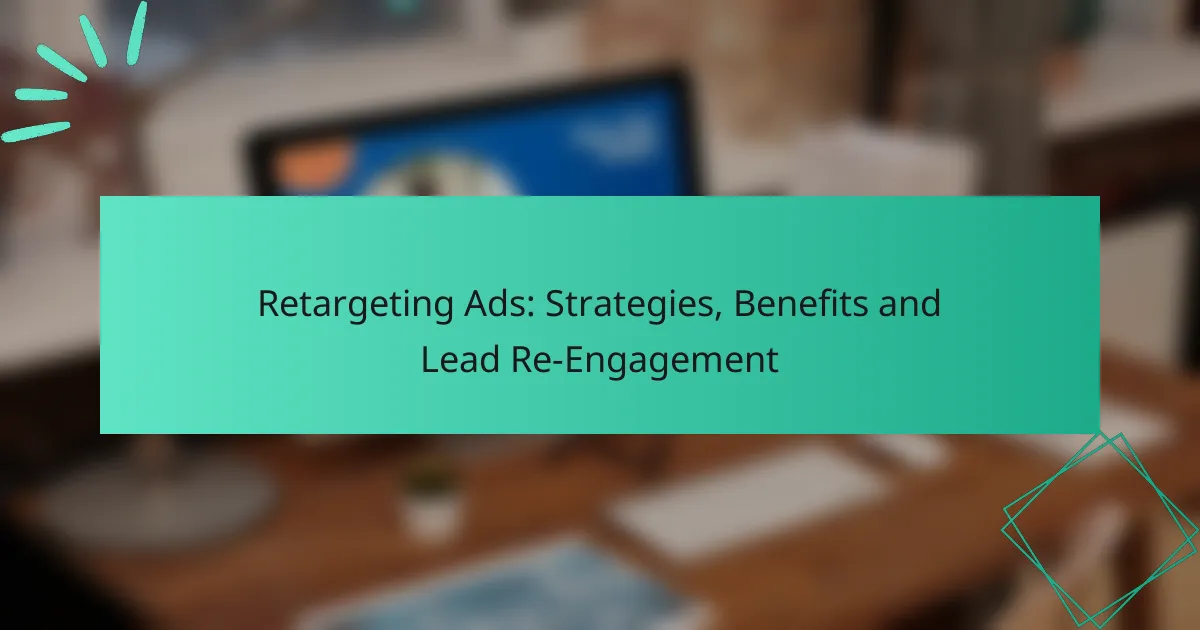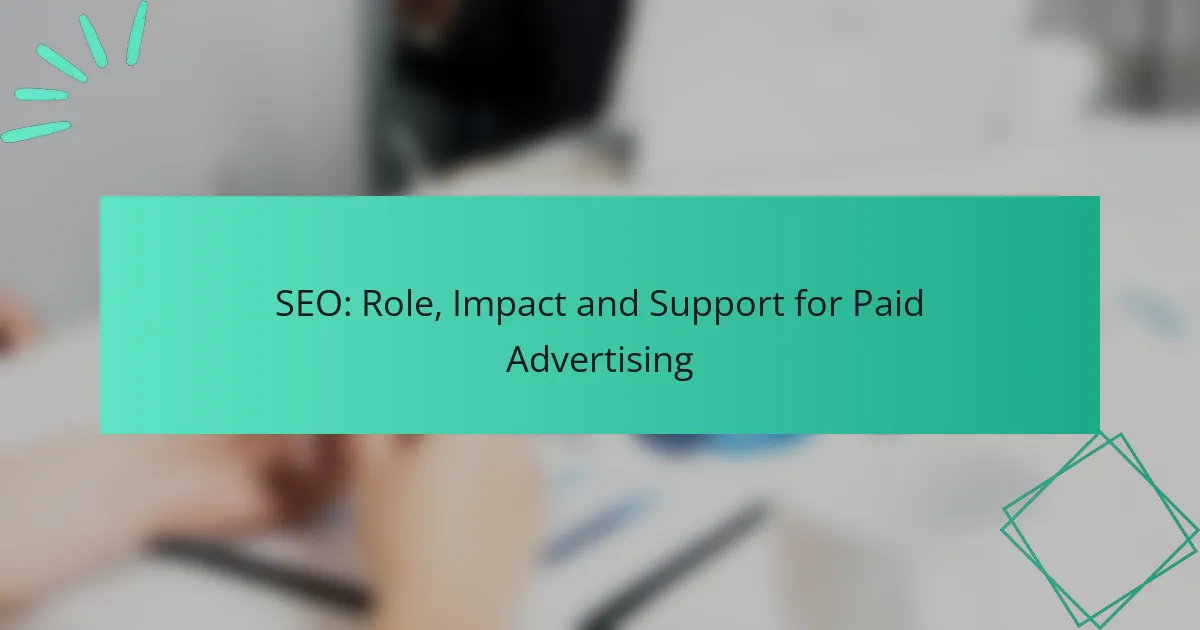When deciding between paid search and organic strategies in Canada, it’s essential to consider your specific goals and resources. Paid search offers rapid visibility and immediate results, making it suitable for time-sensitive promotions, while organic strategies prioritize long-term growth and sustainable traffic through natural search engine rankings.
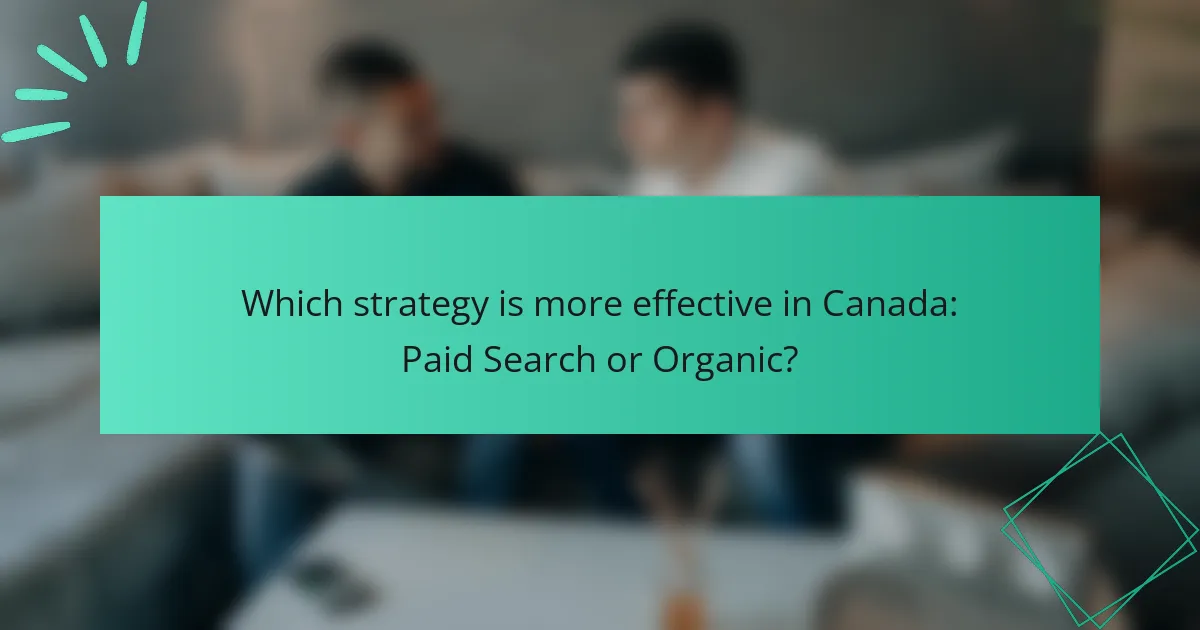
Which strategy is more effective in Canada: Paid Search or Organic?
In Canada, the effectiveness of paid search versus organic strategies largely depends on your immediate goals and resources. Paid search can deliver quick results, while organic strategies focus on building sustainable traffic over time.
Paid Search offers immediate visibility
Paid search provides instant visibility on search engines like Google through ads, allowing businesses to appear at the top of search results almost immediately. This is particularly beneficial for time-sensitive campaigns or new product launches.
With paid search, you can target specific keywords and demographics, ensuring your ads reach the right audience quickly. However, this visibility lasts only as long as you continue funding the ads, making it essential to manage budgets effectively.
Organic strategies build long-term authority
Organic strategies, such as search engine optimization (SEO), focus on improving your website’s content and structure to rank higher in search results over time. This approach builds credibility and trust with users, as organic results are often perceived as more reliable.
While organic strategies take longer to yield results, they can lead to sustained traffic without ongoing costs associated with paid ads. Investing in quality content and optimizing for relevant keywords can enhance your site’s authority and visibility in the long run.
Cost considerations vary significantly
When comparing costs, paid search typically involves a pay-per-click (PPC) model, where you pay for each click on your ad. This can lead to high expenses, especially in competitive markets, but offers precise control over spending.
In contrast, organic strategies often require an upfront investment in content creation and SEO optimization, but they can result in lower long-term costs. Businesses should evaluate their budget and marketing goals to determine the most cost-effective approach.
Target audience engagement differs
Paid search often attracts users who are ready to make a purchase, as they are actively searching for specific products or services. This can lead to higher conversion rates in the short term.
Organic strategies, however, engage users through informative content and brand storytelling, fostering a deeper connection over time. This approach can cultivate brand loyalty and encourage repeat visits, making it valuable for long-term growth.

When should I use Paid Search in Canada?
Paid search in Canada is ideal for businesses looking to achieve quick visibility and immediate results. It is particularly effective when you need to reach specific audiences or promote time-sensitive offers.
For time-sensitive promotions
Paid search is highly effective for time-sensitive promotions, such as seasonal sales or limited-time offers. By using targeted ads, businesses can quickly reach potential customers who are actively searching for relevant products or services.
Consider setting up your campaigns to coincide with key shopping periods, like Black Friday or holiday seasons, to maximize impact. Ensure your ads highlight urgency, using phrases like “limited time only” to encourage quick action.
To target specific demographics
Paid search allows for precise targeting of specific demographics, including age, gender, and location. This capability enables businesses to tailor their messaging and offers to resonate with particular groups, increasing the likelihood of conversion.
Utilize tools like Google Ads to refine your audience settings. For instance, if you sell luxury goods, you might target higher-income brackets in urban areas, ensuring your ads reach the right potential customers.
When launching new products
Launching new products can be challenging, and paid search provides a way to generate immediate awareness. By creating targeted campaigns, you can introduce your new offerings to a broad audience quickly.
Consider using ad extensions to provide additional information about the product, such as pricing or special features. This approach not only informs potential customers but also encourages them to click through to your website for more details.
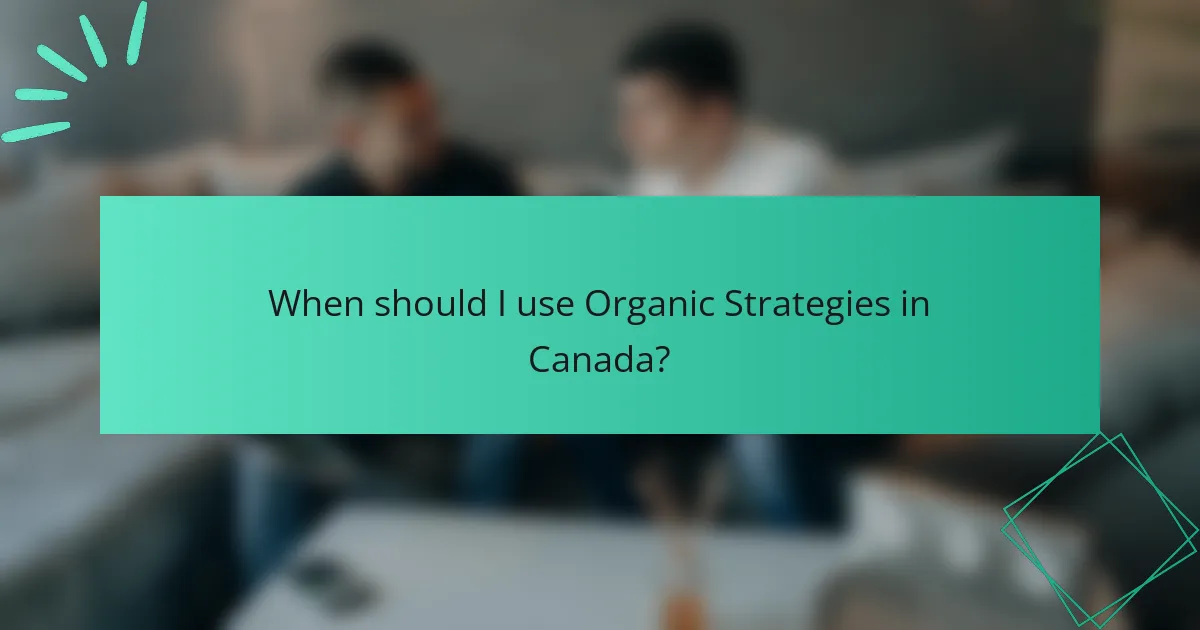
When should I use Organic Strategies in Canada?
Organic strategies should be used when you aim for long-term visibility and sustainable traffic without relying on paid advertising. These strategies focus on optimizing your website and content to rank naturally in search engine results, making them ideal for building a lasting online presence.
For sustainable traffic growth
Organic strategies are essential for achieving sustainable traffic growth over time. Unlike paid search, which provides immediate but temporary visibility, organic methods build a foundation that can lead to consistent visitor numbers. By focusing on SEO best practices, you can improve your site’s ranking and attract users without ongoing costs.
Consider implementing a content calendar that targets relevant keywords and addresses user needs. This approach can help you maintain a steady flow of organic traffic, which is often more cost-effective in the long run.
To enhance brand credibility
Using organic strategies can significantly enhance your brand’s credibility. When users find your website through organic search results, they often perceive your brand as more trustworthy compared to paid ads. This perception can lead to higher engagement and conversion rates.
To bolster credibility, focus on creating high-quality, informative content that addresses your audience’s questions. Engaging in community discussions and earning backlinks from reputable sites can further establish your authority in your industry.
For content-driven marketing
Organic strategies excel in content-driven marketing by leveraging valuable content to attract and retain customers. This approach allows you to showcase your expertise and connect with your audience on a deeper level. By consistently producing relevant content, you can drive organic traffic and encourage user interaction.
Consider using blog posts, infographics, and videos to diversify your content offerings. Additionally, optimizing this content for search engines can help you reach a broader audience while reinforcing your brand message in the Canadian market.
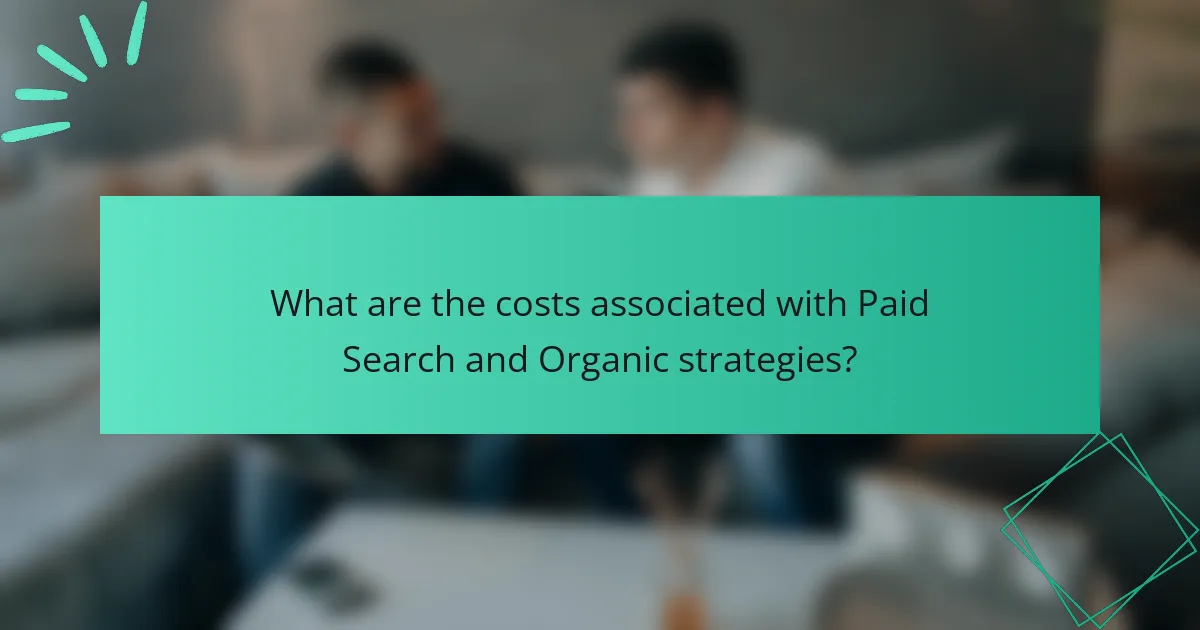
What are the costs associated with Paid Search and Organic strategies?
The costs of Paid Search and Organic strategies vary significantly, impacting budgeting and planning. Paid Search typically involves direct expenses related to bidding for ad placements, while Organic strategies require investment in content creation and SEO efforts.
Paid Search involves bidding costs
Paid Search operates on a bidding model where advertisers pay for clicks on their ads. Costs can fluctuate based on competition, keywords, and the ad platform, often ranging from a few cents to several dollars per click. Advertisers must monitor their budgets closely to avoid overspending.
To maximize efficiency, it’s crucial to select relevant keywords and optimize ad copy. Regularly analyzing performance metrics can help identify which ads yield the best return on investment, allowing for strategic adjustments to bidding strategies.
Organic strategies require investment in content
Organic strategies focus on creating high-quality content that attracts visitors without direct payment for clicks. This approach involves costs related to content creation, SEO tools, and potentially hiring specialists. While initial investments can be significant, the ongoing costs may be lower compared to Paid Search.
Investing in well-researched articles, blog posts, and engaging multimedia can enhance visibility in search results. Consistency in content production and optimization is key to achieving long-term organic growth.
Long-term ROI differs between strategies
The return on investment (ROI) for Paid Search is often immediate, as ads can drive traffic quickly. However, the costs can accumulate over time, leading to diminishing returns if not managed effectively. In contrast, Organic strategies may take longer to yield results but can provide sustainable traffic with lower ongoing costs.
When considering which strategy to use, evaluate your business goals, budget, and timeline. A balanced approach that incorporates both Paid Search and Organic efforts can often yield the best results, leveraging the strengths of each strategy effectively.
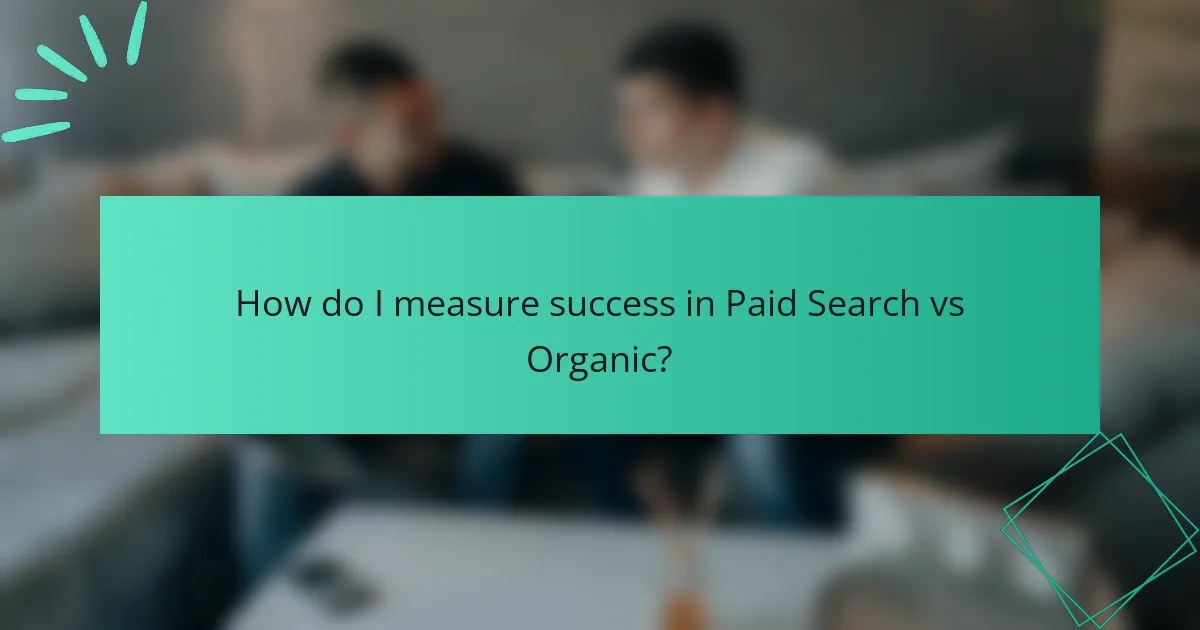
How do I measure success in Paid Search vs Organic?
Success in paid search and organic strategies can be measured through distinct metrics that reflect their unique objectives. Paid search often focuses on immediate results and cost-effectiveness, while organic strategies emphasize long-term growth and visibility.
Paid Search metrics include CPC and CTR
In paid search, key metrics include Cost Per Click (CPC) and Click-Through Rate (CTR). CPC indicates how much you pay for each click on your ad, while CTR measures the percentage of users who click your ad after seeing it. A lower CPC and higher CTR generally signify a more effective campaign.
For example, a CPC of $1 to $3 is common in competitive markets, while a CTR of 2% to 5% is often considered good. Regularly monitoring these metrics helps optimize ad spend and improve campaign performance.
Organic metrics focus on traffic and rankings
Organic strategies primarily measure success through website traffic and search engine rankings. Metrics like the number of visitors, unique visitors, and the position of your website in search results are crucial indicators of organic performance. Higher rankings typically lead to increased traffic.
For instance, achieving a top position on Google can result in a significant boost in organic traffic, often translating to thousands of visitors per month. Tools like Google Analytics can help track these metrics effectively.
Conversion rates are key for both
Regardless of the strategy, conversion rates are essential for evaluating success in both paid search and organic efforts. This metric indicates the percentage of visitors who complete a desired action, such as making a purchase or signing up for a newsletter. High conversion rates suggest effective targeting and messaging.
For both strategies, aim for a conversion rate of around 2% to 5% as a benchmark, though this can vary by industry. Regularly testing and optimizing landing pages can significantly enhance conversion rates across both paid and organic channels.
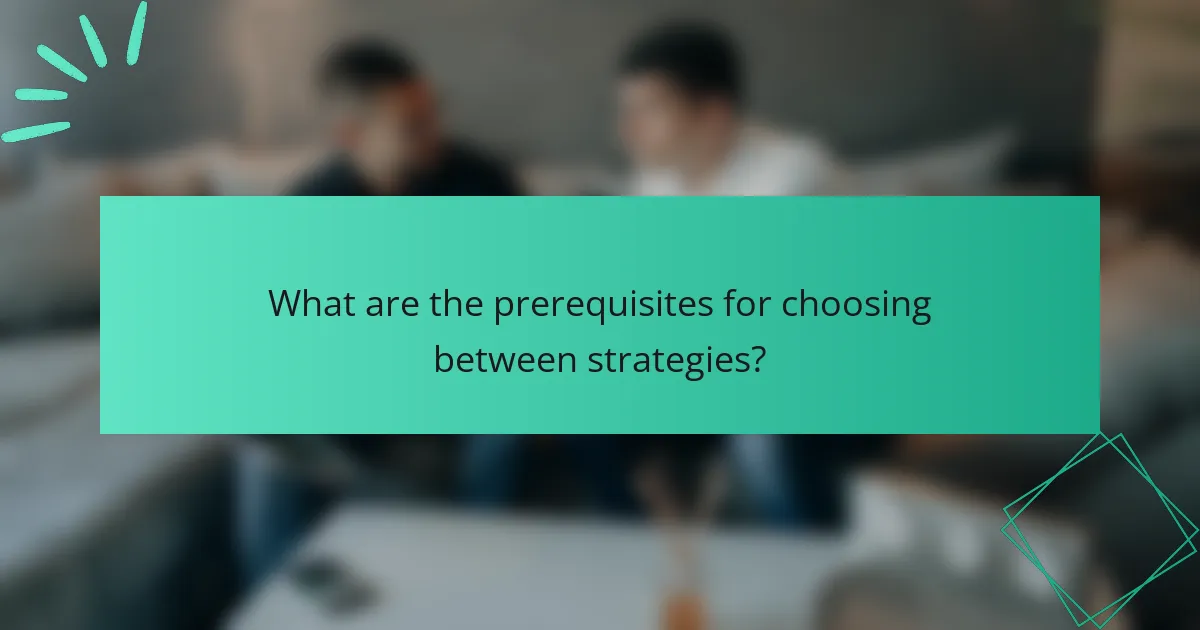
What are the prerequisites for choosing between strategies?
Choosing between paid search and organic strategies depends on several factors, including your business goals, target audience, and available resources. Understanding these prerequisites can help you make an informed decision that aligns with your marketing objectives.
Understanding target audience behavior
To effectively choose between paid search and organic strategies, it’s crucial to understand how your target audience behaves online. Analyze their search patterns, preferences, and the types of content they engage with. For instance, if your audience frequently searches for immediate solutions, paid search might be more effective.
Consider using tools like Google Analytics or social media insights to gather data on user behavior. This information can guide your strategy, helping you determine whether to invest in ads for quick visibility or focus on building organic content for long-term engagement.
Assessing budget constraints
Your budget plays a significant role in deciding between paid search and organic strategies. Paid search often requires a continuous investment, with costs varying based on competition and keywords. If your budget is limited, organic strategies may be more suitable, as they typically involve lower upfront costs but require time to build momentum.
Evaluate your financial resources and consider the potential return on investment (ROI) for each strategy. If you can allocate funds for paid campaigns, weigh the immediate results against the long-term benefits of organic growth. A balanced approach might also be beneficial, using both strategies to maximize reach and effectiveness.

